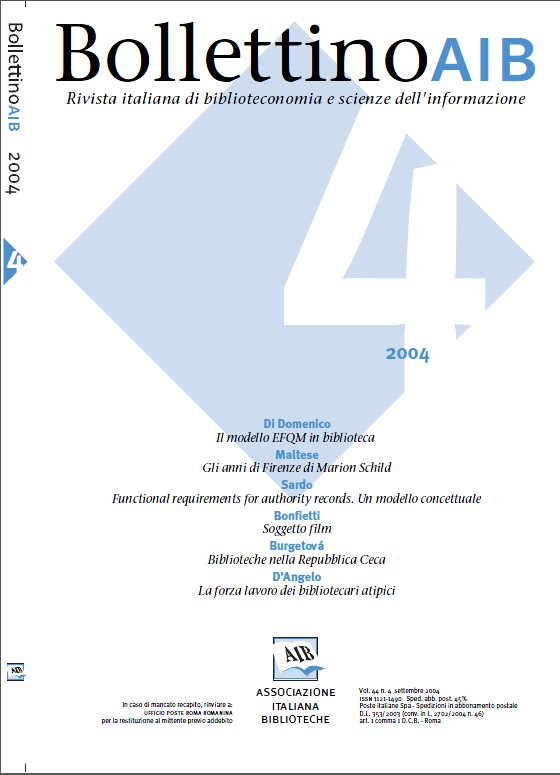The film subject
Main Article Content
Abstract
The problems of choice and form of the access points by author and title characterized the national cataloguing debate for the whole of the last century (and continue to do so). If the Principles of Paris represented a very important point of arrival, above all because they were the first successful attempt at an international agreement within the sphere of semiotic indexing (confirmation being the fact that the majority of subsequent national codes of cataloguing by author and title were based on them) those same Principles obviously reflect the reality of the libraries of the time of their definition. They in fact could not fail to take into consideration, as they did, the limits of paper cataloguing and the manual control operations that this entailed.
Furthermore, the Principles answered on the whole to the requirements of the libraries of the time, the bibliographic patrimony of which consisted of printed books (and manuscripts) in a percentage that more or less corresponded with the total.
Nowadays, with electronic cataloguing, the multiplication of accesses to a sole bibliographic description no longer appears so difficult, the control tools of the forms are more rapidly consultable and the update of an access point involves just one operation.
On the other hand, just to complicate things, libraries have been enriched with a much more extensive variety of materials, the nature of which foresees authorial functions that differ from those that can be identified in a work that is mainly expressed in written form. The new Principles of Frankfurt try to take into account these and other evolutions and, moreover, they have set themselves (with results that have not been entirely positive up to now) the ambitious task of covering the field of indexing by subject with a single international cataloguing code.
This contribution intends analysing some title subjects and especially comparing the solutions adopted for indexing works regarding the literary sphere (traditional artistic work preserved in libraries) rather than that of cinema (a relatively recent acquisition of libraries and consequently of their catalogues); in both cases the Italian practice was compared with solutions adopted in foreign library catalogues, with a view to finding possible suggestions for a future draft of the regulations for the New Subject Catalogue, the project of which is in the process of implementation at the National Central Library of Florence.
Furthermore, the Principles answered on the whole to the requirements of the libraries of the time, the bibliographic patrimony of which consisted of printed books (and manuscripts) in a percentage that more or less corresponded with the total.
Nowadays, with electronic cataloguing, the multiplication of accesses to a sole bibliographic description no longer appears so difficult, the control tools of the forms are more rapidly consultable and the update of an access point involves just one operation.
On the other hand, just to complicate things, libraries have been enriched with a much more extensive variety of materials, the nature of which foresees authorial functions that differ from those that can be identified in a work that is mainly expressed in written form. The new Principles of Frankfurt try to take into account these and other evolutions and, moreover, they have set themselves (with results that have not been entirely positive up to now) the ambitious task of covering the field of indexing by subject with a single international cataloguing code.
This contribution intends analysing some title subjects and especially comparing the solutions adopted for indexing works regarding the literary sphere (traditional artistic work preserved in libraries) rather than that of cinema (a relatively recent acquisition of libraries and consequently of their catalogues); in both cases the Italian practice was compared with solutions adopted in foreign library catalogues, with a view to finding possible suggestions for a future draft of the regulations for the New Subject Catalogue, the project of which is in the process of implementation at the National Central Library of Florence.
Article Details
Section
Articles

This work is licensed under a Creative Commons Attribution-ShareAlike 4.0 International License.
